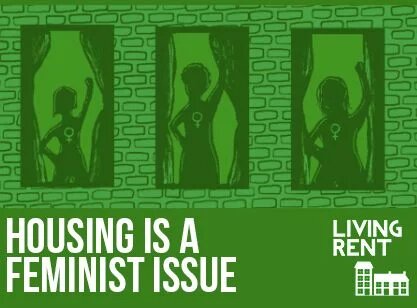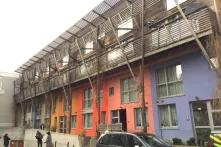While the discourse around housing is often developed in terms of the right to access housing or housing policies, it is important that housing is equally understood as the lived physical and social space in which we develop, negotiate, and challenge gendered relations and norms. Indeed, housing is a gendered issue for many reasons. For example, the lack of affordable housing puts women and femininities at risk of domestic violence and may prevent those experiencing abuse from leaving. Also, the lack of a safe home has a more adverse impact on those with caring responsibilities.

The gendered dimension of (collective) housing
The gendered dimension of housing can be understood at two interrelated levels. The first concerns the built environment and the organisation and design of the physical space of the dwelling. The architecture and design of housing play an undeniably important role in reproducing or challenging dominant gender roles and social norms. The natural space of the dwelling is not just a container in which people live; it actively shapes habitation. The size of the dwelling, the design of the spaces, and the configuration of the interior space and furniture have a significant impact on whether the dwelling is experienced as a place of care or not. Important examples of alternative housing design are social and/or collective housing complexes, where designers and residents experiment with different models of living together. A typical example is the Frauen-Werk-Stadt housing complex in Vienna, which was designed by female architects with a focus on the residents’ everyday lives, an emphasis on open collective spaces, designing apartments for people at different stages of their lives, and strengthening the feeling of security for women and children.
The second level has to do with the gendered social relations that develop within the residence. The home is a hub of caring practices and social reproduction; it includes the physical and emotional (usually unpaid) labour associated with childcare or care for the elderly, looking after the house itself, self-care, but also communal caring practices, for example when neighbours look after each other’s houses, look after the house and children, or support their elderly neighbours. However, caring cannot be seen as a natural instinct or an a priori morally good practice; it must be understood as a political practice that always involves power relations. Thus, at the residential level, care labour is unequally distributed according to gender, race, class, age, and so on, and is seen as belonging primarily to the private female sphere.
Access to housing: towards an intersectional approach
The gendered dimensions of housing precarity extend beyond women to people from the LGBTQI+ community, who consistently face conditions of exclusion. In many cases, the main cause of exclusion is the cessation of family support, which can take the form of direct or indirect eviction from home—even before adulthood—or the cessation of financial support as well. In Greece in particular, the lack of a broader framework of support for access to housing and the lack of alternatives outside the conventional market, makes the role of family networks crucial. At the same time, homophobic and transphobic attitudes of landlords who refuse to rent their properties to people whose LGBTQI+ identity is visible are common. Furthermore, an intersectional approach to LGBTQI+ access to housing highlights a range of multi-layered exclusions related to access to education, decent work, social inclusion, and visibility that lead, both independently and through their intersections, to reduced income and opportunities.
The above conditions are in no way mitigated by the existing institutional framework, as the existing accommodation structures either reject LGBTQI+ people or fail to provide them with conditions of safety and inclusion. In this context, LGBTQI+ people develop individual “survival” strategies while often relying on informal community support networks to gain permanent or temporary access to housing. The former include concealing or disguising LGBTQI+ identities and interpersonal relations, as well as renting from community members or allies. Support networks are mainly digital (groups on social media platforms), in many cases with the support or coordination of relevant NGOs, grassroots and informal groups of the LGBTQI+ community. Through these networks, community members offer temporary accommodation to LGBTQI+ people who are in search of shelter and have limited resources and access to networks and job opportunities. However, the solutions offered are mainly temporary, with a number of broader issues, such as limited NGO resources and the legal complications that can arise from sheltering minors, posing further constraints.
Cooperative housing and gender issues
The question, then, is how—in what way and to what extent—cooperative and collective forms of housing seek in practice to challenge gender stereotypes in the organisation of housing and to renegotiate the gendered roles of housing members. At the level of spatial design, a typical example is the common spaces that are a structural element of cooperative housing. Common spaces contribute to challenging the strict “public/private” dichotomy that dominates contemporary capitalist societies, identifying the private with the female and downplaying the importance of the labour required for the social reproduction of household members. On an institutional level, among the constant demands of the LGBTQI+ community, as expressed by institutional and informal organisations and groups, is the creation of guest houses, which should include provisions for minors. However, alongside this demand, the institutionalisation of a broader framework for cooperative housing will provide the opportunity for LGBTQI+ people to create their own safe spaces for coexistence and mutual support, while contributing to increased community visibility.
References
- Dagkouli-Kyriakoglou, M. (2021) ‘When housing is provided, but you have only the closet’. Sexual orientation and family housing support in Athens, Greece, Social & Cultural Geography. doi: 10.1080/14649365.2021.1910989.
- Pettas D., Arampatzi A. and Dagkouli-Kyriakoglou M. (2022) LGBTQ+ housing vulnerability in Greece: Intersectionality, coping strategies and the role of solidarity networks. Housing Studies. DOI: 10.1080/02673037.2022.2092600.
- Kapsali, M. (2020) Political infrastructures of care: Collective home making in refugee solidarity squats. Radical Housing Journal, 2(2), 13-34.
- Power, E. R. & Mee, K. J. (2020) Housing: an infrastructure of care. Housing Studies, 35(3), 484-505.
- Geltis, Th. (2019) LOATKI Astegoi kai Diktya Stegastikhs Yposthrixhs. In Kourachanis N. (ed.) Katoikia kai Koinwnia: Problhmata, Politikes kai Kinhmata. Athens: Dionicos. ISBN: 9789606619915.


